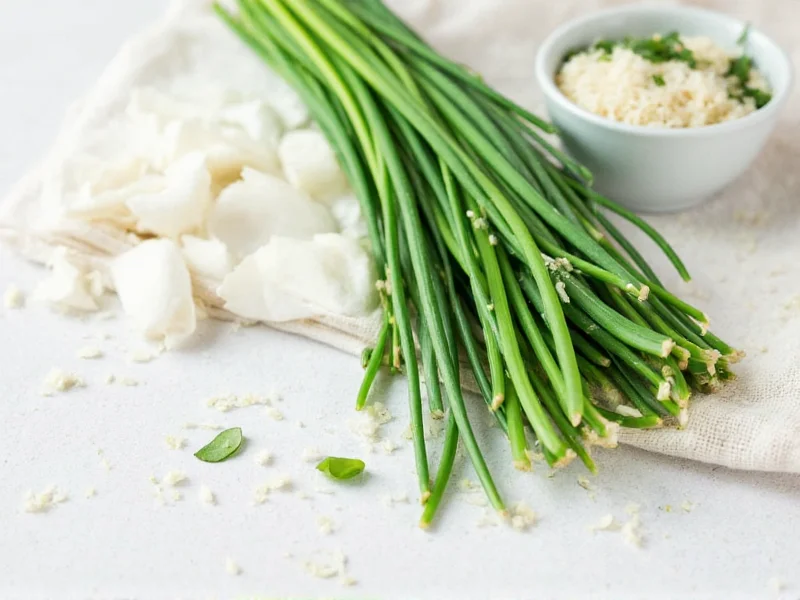When you're preparing a recipe calling for garlic chives but find your pantry lacking, knowing the right substitute can save your dish. Garlic chives (jiu cai in Chinese cuisine) offer a unique flavor profile—milder than regular garlic with a delicate onion-like sweetness and subtle garlic notes. Understanding what makes them special helps you choose the most appropriate replacement.
What Are Garlic Chives and Why Substitute?
Garlic chives differ from common chives (Allium schoenoprasum) by having flat leaves instead of hollow tubes and delivering a more pronounced garlic flavor. They're essential in many Asian dishes like Chinese dumplings, stir-fries, and Korean garlic chive pancakes. When unavailable, you need substitutes that balance the onion-garlic flavor profile without overwhelming your dish.
Top Garlic Chives Substitutes Ranked by Effectiveness
1. Regular Chives + Fresh Garlic (Best All-Around Substitute)
This combination most accurately replicates garlic chives' flavor profile. Use this ratio:
- 1 tablespoon fresh regular chives + 1/8 teaspoon minced garlic = 1 tablespoon garlic chives
- For cooked dishes: Add garlic early, chives at the end
- For raw applications: Mix and let sit 5 minutes before using
This garlic chives replacement works well in most recipes, from dumpling fillings to salad garnishes. The fresh chives provide the grassy note while the garlic adds the necessary pungency without being overwhelming.
2. Chinese Chives (Jiu Cai) - The Authentic Alternative
If available at Asian markets, Chinese chives are actually the same plant as garlic chives (Allium tuberosum). They're often labeled differently based on regional naming conventions. When substituting:
- Use 1:1 ratio as direct replacement
- Look for flat, dark green leaves (not hollow like common chives)
- Store wrapped in damp paper towel in vegetable drawer
This garlic chives alternative for Asian recipes maintains authentic flavor but may be difficult to find outside specialty markets.
3. Green Onions/Scallions (Good for Texture)
When you need both flavor and visual appeal:
- Use green parts only for closest color match
- Substitute 2:1 ratio (2 parts scallion greens = 1 part garlic chives)
- Add at the end of cooking to preserve freshness
This substitute for garlic chives in stir-fry works well when you prioritize texture and appearance over precise flavor replication. The white parts are too strong, so use only the dark green sections.
Substitutes to Use with Caution
Some common alternatives require careful handling to avoid ruining your dish:
- Regular garlic: Too intense—use only 1/4 the amount and cook thoroughly to mellow flavor
- Garlic powder: Lacks freshness—use 1/16 teaspoon powder + 1 tablespoon chives per tablespoon needed
- Onion powder: Different flavor profile—best avoided unless combined with fresh chives
- Leeks: Milder but work in soups—use inner white parts only at 3:1 ratio
Best Substitutes by Dish Type
Different recipes require tailored approaches. Here's what works best for specific applications:
| Dish Type | Best Substitute | Ratio | Special Tips |
|---|---|---|---|
| Dumpling filling | Regular chives + garlic | 1 tbsp chives + 1/8 tsp garlic | Add garlic first, let sit 5 min before mixing with chives |
| Stir-fries | Green onion greens | 2:1 (scallion:garlic chives) | Add during last 2 minutes of cooking |
| Garlic chive pancakes | Chinese chives (jiu cai) | 1:1 | Must use authentic Chinese chives for proper texture |
| Soups & broths | Leek greens + garlic powder | 1 tbsp leek + pinch garlic powder | Add leeks early, garlic powder at the end |
| Raw applications (garnish) | Chives + garlic-infused oil | 1 tbsp chives + 1/4 tsp oil | Mix oil with chives just before serving |
Pro Tips for Successful Substitution
Mastering garlic chives replacement requires attention to detail:
- Timing matters: Add garlic elements early in cooking, fresh substitutes at the end
- Adjust gradually: Start with less substitute, taste, then add more as needed
- Consider texture: For dishes where garlic chives provide visual appeal (like dumplings), match the thin, delicate appearance
- Raw vs. cooked: Raw substitutions need more precision than cooked applications where flavors meld
- Storage note: Fresh substitutes lose potency quickly—use within 24 hours of preparation
Common Substitution Mistakes to Avoid
Even experienced cooks make these errors when seeking a garlic chives alternative:
- Using regular garlic cloves at 1:1 ratio (overwhelms dish)
- Substituting onion instead of scallion greens (too strong)
- Adding substitutes too early in cooking (loses delicate flavor)
- Using dried chives (lacks necessary moisture and freshness)
- Ignoring the visual component in presentation-focused dishes











 浙公网安备
33010002000092号
浙公网安备
33010002000092号 浙B2-20120091-4
浙B2-20120091-4